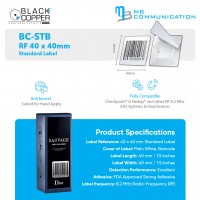No products
New products
-

BlackCopper BC-EGP-10G015-Z
Transform Your Business with BlackCopper BC-EGP-10G015-Z Dual Screen POS...
Rs 0
Catalog
Soft Tags: A Comprehensive Guide
Soft tags are a crucial aspect of website optimization and content marketing. Understanding how to effectively utilize them can significantly boost your search engine ranking and attract a wider audience. This guide provides a comprehensive overview of soft tags, their importance, and best practices for implemen...
Soft Tags: A Comprehensive Guide
Soft tags are a crucial aspect of website optimization and content marketing. Understanding how to effectively utilize them can significantly boost your search engine ranking and attract a wider audience. This guide provides a comprehensive overview of soft tags, their importance, and best practices for implementation.
What are Soft Tags?
Soft tags, also known as semantic tags, are HTML elements used to enhance the meaning and structure of your web content. Unlike hard tags like
or
, soft tags do not directly impact the visual layout of your website. Instead, they provide context and information to search engines and screen readers, helping them better understand the content on your page.
Benefits of Using Soft Tags
- Improved Search Engine Ranking: Soft tags help search engines understand the context and relevance of your content, leading to better rankings in search results.
- Enhanced User Experience: Soft tags can improve the accessibility and readability of your website for users with disabilities or who rely on screen readers.
- Increased Engagement: By providing clear semantic information, soft tags can help users quickly navigate and understand your website's content.
- Better Content Organization: Soft tags help you organize your content in a logical and meaningful way, making it easier for users to find what they need.
Common Soft Tags and Their Uses
Here are some of the most commonly used soft tags and their applications:
and
The tag is a generic inline element used to group and style text without changing its structure. It's often used in conjunction with CSS to apply specific formatting to particular parts of a sentence.
and
The tag indicates that the enclosed text is important or strong, while the tag emphasizes a word or phrase.
The tag defines an abbreviation or acronym. It allows you to provide a full definition for the abbreviation, which is displayed when users hover their mouse over it.
The tag is used to display code snippets or computer code. It applies a monospace font and other styling elements to make code blocks visually distinct.
The tag highlights text, typically for drawing attention to specific words or phrases. It's often used to display search terms or important information.
The tag represents a specific date or time. It allows you to provide a human-readable format while also providing a machine-readable timestamp that search engines can understand.
The tag is used to represent a machine-readable value, such as a measurement or a price. It allows you to provide a human-readable format along with a machine-readable value that search engines can interpret.
Using Soft Tags Effectively
Here are some tips for using soft tags effectively to enhance your website's SEO and user experience:
1. Use Soft Tags Purposefully
Avoid using soft tags simply for styling. Their primary function is to provide semantic information, so choose them based on the meaning of the content, not just for visual effects.
2. Choose the Right Soft Tag
Select the appropriate soft tag based on the specific context of the content. Use for important words, for emphasis, for abbreviations, etc.
3. Use Soft Tags Consistently
Maintain consistency in your use of soft tags across your website. Applying them consistently makes it easier for search engines and users to understand your content.
4. Don't Overuse Soft Tags
Too many soft tags can make your content difficult to read and can actually hinder SEO. Use them sparingly and strategically.
Conclusion
Soft tags play a vital role in enhancing the structure, meaning, and accessibility of your website content. By using them effectively, you can improve your search engine ranking, enhance user experience, and attract a wider audience. Remember to choose the right tags, use them consistently, and avoid overusing them. Implement these best practices to unlock the full potential of soft tags and elevate your website's performance.
For further assistance with soft tags or any other aspects of website optimization, contact MB Communication. We're dedicated to helping businesses like yours achieve online success.
Soft Tags There is 1 product.
-
Black Copper BCSTB
Soft Tag – RF RF Frequency Flat reusable soft security tag. Ideal for inserting into wallets, bags Looks like a product label Checkpoint & other RF systems compatible
Rs 4In Stock





